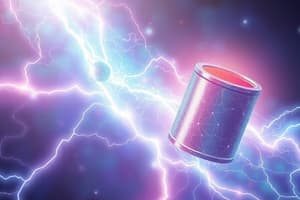Podcast
Questions and Answers
What is the force that objects exert on each other due to their electric fields?
What is the force that objects exert on each other due to their electric fields?
- Electric force (correct)
- Magnetic force
- Gravitational force
- Kinetic force
What is the region around a charged object in which an electric force is exerted on another charged object?
What is the region around a charged object in which an electric force is exerted on another charged object?
- Electric current
- Electric field (correct)
- Electric charge
- Electric potential
What is the basic carrier of positive charge in nature?
What is the basic carrier of positive charge in nature?
- Proton (correct)
- Neutron
- Electron
- Photon
What happens when an object is charged?
What happens when an object is charged?
What type of material allows electric charges to move freely?
What type of material allows electric charges to move freely?
Flashcards are hidden until you start studying
Study Notes
-
Electricity is the force that objects exert on each other due to their electric fields.
-
Electric force is the force of attraction or repulsion on a charged particle that is due to an electric field.
-
The size of an electric field depends on two things: the amount of charge on each object (the greater the charge is, the greater the electric force) and the distance between the charges (the closer the charges are, the greater the electric force is).
-
An electric field is the region around a charged object in which an electric force is exerted on another charged object.
-
A charged object in the electric field of another charged object is attracted or repelled by the electric force acting on it.
-
Nature's basic carrier of positive charge is the proton.
-
Protons do not move from one material to another because they are held firmly in the nucleus.
-
If electrons = protons, then the object is said to be neutral.
-
If electrons > protons, then the object is said to be positively charged.
-
If electrons < protons, then the object is said to be negatively charged.
-
Electric charge is a conserved quantity that cannot be created or destroyed, but it can be transferred between objects.
-
When an object is charged, it exerts an electric force on other objects.
-
Conductors are materials in which the electric charges move freely in response to an electric force.
-
Insulators are materials in which electric charges do not move freely.
-
Semiconductors are materials in between insulators and conductors.
-
It is acceptable for public money to be used for the acquisition of works of art in a society where this is legal.
-
phin B. Salmon C. Blue-fin Tuna *D. Blue Whale
- In your society, to what extent is it acceptable for public money to be used for the acquisition of works of art?
Studying That Suits You
Use AI to generate personalized quizzes and flashcards to suit your learning preferences.




